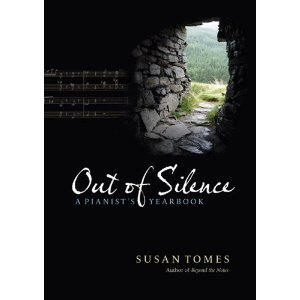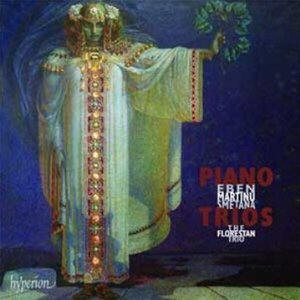|
You are reading the older HTML site
Positive Feedback
ISSUE
49
Notes of an Amateur:
Tomes; the Florestan Trio
Out of Silence: A Pianist's Year Book, Susan Tomes. Boydell & Brewer. Scottish pianist Susan Tomes, soloist and one-third of the Florestan Trio, is not so distinguished a personage (she would say not a "senior pianist") that we seek out her Year Book of brief penseés to learn more about her. As 'senior' pianist Graham Johnson said to her (in praise, she later realizes), she "is not enough of a charlatan" to have achieved such status. What we come to Tomes for is her insights into music and music-making. She has written on this subject before, notably in Beyond the Notes six years ago, also published by Boydell. As good and insightful as the earlier book is, this one is better still. And before we're through, we do learn a good deal about her and to a degree why the Florestan Trio sounds as it does as well. Tomes' chief virtue as a writer on music is her gift for providing us with genuine intellectual goods in the voice of a fellow music-lover rather than academician. Her often perfect comparisons and references tend to be 'homely' -- that is, grounded in everyday experience, much of which we share with her. She writes as a musician who lives in both our world and the world of a classical music performer, often simultaneously. She ranges widely in the music world for material to talk about, taking us into rehearsals, master classes, concerts, green rooms, musical families, even into the kinds of dreams and thoughts performers have, what they look for and 'see' walking on a beach. Some of her most interesting commentary concerns the making of the latest Florestan recording reviewed below. The danger of a day (year) book is that like any anthology of occasional writing, some of the pieces will fall below the level of consequence of the others, which is in the nature of the genre. Tomes has a few of these but they are rare. She has the literary gift of knowing when an experience makes a larger point without its always being necessary to draw our attention to it. The essays which demonstrate this gift are among the best. She is especially effective at not drawing too explicit a lesson in her piece on teaching. She finds it nearly impossible to instruct a music student unless she teaches from her informed sense of how the work should go, yet suspects this is a failure on her part. She senses that like one of her teachers, György Sebök, she should be able to get beyond her own sense of the perfect performance to hear and see it from where the student seems to want to take it. I'll leave the specifics of that story for you to find for yourself. She can also be explicit about such larger issues, as she in a comparison of art and sport (sic), where she is profound in her usual seemingly casual way about how sport seems to take its very meaning from having its end in doubt until it arrives; music and literature from (after the first of many listenings and readings) our already knowing the end, inducing us to focus on matters of style where other kinds of meaning lie. Long about this point (August), I found my focus changing. I stopped reading for information and insights into music and began listening to the pianist herself in her writing, the musician I have come to know over the past few years, on her many CD's and 'live' at Union and Amherst Colleges with the Florestan Trio. I began listening to the musical mind and sensibility at the heart of the performances and gradually came to hear the classical mind I refer to in my Florestan review below. Hers is a sensibility that consciously eschews excess, eccentricity, irrelevant flamboyance & drama; and brings to everything she plays a point of view, consciously informed by the continuity of the Western classical music tradition of how its individual works should go. She understands a work as a flowing, connected whole, whose individual parts must not rise above and disrupt the argument the work is attempting to make. She sees herself, the performer, as critical to a work's realization but more as an agent charged with conducting the argument effectively, eloquently if the stars align, rather than turning it into something grander or more (or less) passionate than it is. She is a performer who believes that control and discipline can liberate a work (from its performer as well as from the bare details of the score) rather than hold it down. Again, she takes a classical view of her vocation and we hear this both in her playing and in her writing. The greatest compliment I can pay Out of Silence is that it has made me want to listen to more music and to listen more attentively. Susan Tomes has sent me back to her recordings, just as reading Words in Air, the letters of Robert Lowell and Elizabeth Bishop, sent me back to their poems. Far too few books about art-making can do that.
Eben, Martinü, Smetana. Piano Trios. The Florestan Trio, Hyperion Records. CDA 67730. As authoritative as the Florestan Trio have become in the standard piano trio repertoire, it is a treat to hear them venturing off the established path in this new CD representing three generations of Czech music. They are even more versatile to my ears than their esteemed predecessors, the Beaux Arts Trio, and it's fun to hear this demonstrated as dramatically as it is here, particularly in the Petr Eben work, composed in 1986. It is a work a more aggressive ensemble could bowl over, but the Florestan's classical poise and control let it do the modernist dance it clearly wants to do. The group's acclaimed clarity keeps the three instrumental voices on more equal footing than we are accustomed to hearing from trios. It is nice to hear cellist Richard Lester get some of his own lines to play! This is a fine and spirited performance, letting us greedily imagine a Shostakovich/Ives pairing sometime down the road. There is a lot of twentieth century Czech composer Bohuslav Martinü that sounds like a lot of other Bohuslav Martinü, which is fine if you like him, which I generally do. But some of his music strikes out into more idiosyncratic, vigorously neo-classic territory, in particular some of his chamber music. The Nonets, Madrigals and Cello Sonatas are wonderful, and so in this Trio No. 1 (1930). The only significant disappointment is the work's short length! Five brief sections totaling just over ten minutes in all. The chief audible influence, and a fruitful one for Martinü, is Stravinsky, providing a chromatic melodic undercurrent to all of the vigorous counterpoint in the fast sections, which moves into the foreground in the slower ones. What is especially interesting is hearing echoes of Shostakovich's two piano concertos, written in 1933 and 1957, proving that Martinü is our most prescient composer! Tomes is especially brilliant in this work. Some critical simplemindedness: If you marry Schumann's and Lizst's bold versions of romanticism with Dvorak's gentler, more melodic version, you come out with Bedrich Smetana's Piano Trio in G Minor (1855). And it is a marriage that works just fine, especially in the hands of the Florestan Trio, who narrow what in the hands of a more indulgent ensemble would be a large gap to something musically persuasive and satisfying. The Florestan musicians refuse to exaggerate differences. In their hands, the Smetana trio sings its goodly heart out. This is a work I have heard the trio play 'live,' and despite Susan Tomes' concerns that recorded performances often lose some of the best qualities of 'live' outings, I can reassure her that this recorded Smetana does just fine. It is the richest work on the program and it is great to hear it again. The way the introductory section prepares us for the first lyrical theme played by the cello and then piano is eloquent and truly sets up the work. If you enjoy fulsome, romantic mid-nineteenth century music played with affection and elan, you will appreciate just how good a performance this is. Lester and Anthony Marwood are conspicuously excellent, thanks in large part to Smetana who gives them a plethora of great lines. System used for the audition of the CD's: Audio Note CDT3 transport and Dac 4.1 Balanced Signature. Blue Circle BC 3000II GZpz preamplifier and BC 204 amplifier. Jean Marie Reynaud Orfeo II loudspeakers. With Blue Circle BC6000 line conditioner. Audio Note Pallas and Sootto interconnects; Audio Note Sogon speaker cables. Bob Neill, in addition to being an occasional equipment and regular music reviewer for Positive- Feedback Online, is also proprietor of Amherst Audio in Amherst, Massachusetts, which sells equipment from Audio Note, Blue Circle, and JM Reynaud, among others.
|


